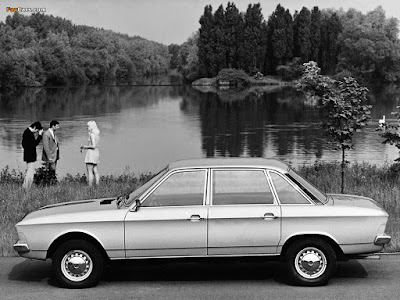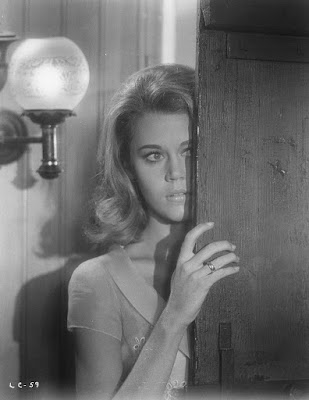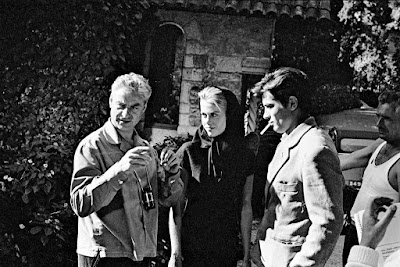In 1968 the first two "Sophie" albums, "Het ei van Karapolie" (Original title: "L'Œuf de Karamazout") and "De bel der stilte" (Original title: "La Bulle du silence", are published by Dupuis. The series was created by Jidéhem (Jean De Mesmaeker) (drawings) sometimes assisted by Vicq (Antoine Raymond) (stories). The stories were pre-published in the Belgian comics magazine Spirou/Robbedoes.
The series features Sophie, an eleven year old dark-haired girl, created by her father Mr. Karapolie (French: Karamazout) after the famous English saying where girls are made of: “Sugar and spice and everything nice”. She wears her long hair in two pigtails and she has an extensive wardrobe. Unlike many comic characters Sophie almost never wears the same outfit. Other characters are Mr. Karapolie, the father of Sophie and electrical engineer by profession. Starter a mechanic, he also tests vehicles for Spirou/Robbedoes. Pieters (French: Pipette), the best friend of Starter, is also working for Spirou/Robbedoes as a tester. Jozef (French: Joseph) is the butler of Sophie and her father, he cooks and maintains the house. Bertje (French: petit Bernard) is Sophies best friend. Zoef (French: Zoë), a black old-timer equipped with an electronic brain by its creator Mr. Buis.
In 1957 Jidéhem was given the car section of Spirou/Robbedoes so he created Starter. Starter was also the main character of Jidéhems first own comic series with two short stories, "La révolte des autos" (1959) and "Histoire de l'automobile" (1960) in Spirou/Robbedoes. The first full story "Starter contre les casseurs" was published in Spirou/Robbedoes in 1961. This was followed by "La maison d'en face" published in Spirou/Robbedoes in 1963.
Jidéhem wanted to introduce a female main character in Spirou/Robbedoes, his first sketches of a sexy 17- to 18-year-old girl were not accepted by publisher Dupuis. Dupuis was convinced that a female protagonist would not appeal to the Spirou/Robbedoes readers. Jidéhem did get permission to draw a little girl to play as a secondary role in his stories. He called the girl Sophie Karapolie (French: Sophie Karamazoet). Her first name he borrowed from the French actress Sophie Desmarets. The original French name Karamazout is referring to The Brothers Karamazov by the Russian author Fyodor Dostoyevsky. Jidéhems own newborn daughter was also named Sophie. Sophie would initially play only in one story, "Het ei van Karapolie" (Original title: "L'Œuf de Karamazout") (1964), but the character became far more popular than Starter.
![]() |
| Cover No 1 "Het ei van Karapolie" |
No 1 "Het ei van Karapolie"
- full-colour
- never published in English
- story and drawings by Jidéhem (Jean De Mesmaeker)
- Original French title: "L'Œuf de Karamazout"
- pre-publication in Spirou/Robbedoes no 1345 – 1365 (1964)
- contains the short story “De Jan-allemachtig” (story by Vicq (Antoine Raymond)) (Original French title: “La Pelle mécanique”) (pre-publication in Spirou/Robbedoes no 1476 (1966))
Synopsis "Het ei van Karapolie" ("L'Œuf de Karamazout")
On a quiet day Starter and Pieters (Pipette) are on a trip in Zoef (Zoë), passing at the car junkyard they are almost hit by a red Fiat. At the junk yard they find the beaten owner. After gaining consciousness he tells Starter and Pieters the thugs were looking for a little girl. It turns out that the little girl, called Sophie, was hiding in a closet. The thugs wanted to kidnap Sophie to blackmail her father, Mr. Karapolie, to force him to hand over his latest invention...
Main characters in this story are Sophie, Starter, Pieters (Pipette), Mr. Karapolie (Mr. Karamazout), Zoef (Zoë), Jozef (Joseph) and Zjuul.
![]() |
| Sophie, Mr. Karapolie and Jozef |
![]() |
| Sophie, Starter and Pieters |
![]() |
| Starter and Pieters |
![]() |
| Zjuul |
Cars:
- Zoef (Zoë) probably based on the Guust Flater (Gaston Lagaffe) car a Fiat 509
- Fiat 1800/2100
- Citroën DS (4x)
- Citroën 2CV
- Citroën probably B12
- Alfa Romeo 2600 Berlina
- Renault 4
- Renault 8
- Truck Berliet type ?
- Renault Goélette
- Peugeot 403
- Peugeot 404
![]() |
| Zoef and Fiat 1800/2100 |
![]() |
| Citroën DS |
![]() |
| Alfa Romeo 2600 Berlina |
![]() |
| Truck Berliet type ? |
![]() |
| Citroën DS, Citroën B12 (?) and Citroën 2CV |
![]() |
| Peugeot 403 and Zoef |
![]() |
| Peugeot 404 |
![]() |
| Renault 4, Renault 8, Citroën B12 (?) and Citroën DS |
![]() |
| Zoef and Renault Goélette |
Synopsis “De Jan-allemachtig” (“La Pelle mécanique”)
Sophie and Bertje (petit Bernard ) are on holiday at the seaside. Sophie proudly displays the latest invention of her father, a mini-excavator that radio can be controlled. Suddenly a number of banknotes arrive, carried by the wind. All the ten dollar bills have the same number...
![]() |
| Bertje and Sophie |
![]() |
| Doris and Fred |
Main characters in this story are Sophie, Bertje (petit Bernard), Doris and Fred.
![]() |
| Cover No 2 "De bel der stilte" |
No 2 "De bel der stilte"
- full-colour
- never published in English
- story by Vicq (Antoine Raymond) and drawings by Jidéhem (Jean De Mesmaeker)
- Original French title: "La Bulle du silence"
- pre-publication in Spirou/Robbedoes no 1433 – 1458 (1965)
- contains the short story “De toverput” (story by Vicq (Antoine Raymond)) (Original French title: “Le Puits magique”) (pre-publication in Spirou/Robbedoes no 1444 (1965))
Synopsis "De bel der stilte" ("La Bulle du silence")
Starter and Pieters (Pipette) visit the Karapolie (Karamazout) family. Sophie is playing with her new toy the "super jokari", and Sophie's father is happy to present his newest invention, a bubble that can silence all sound within a certain radius...
Main characters in this story are Sophie, Starter, Pieters (Pipette), Mr. Karapolie (Mr. Karamazout), Jozef (Joseph), John Minzwijnoff, Bob, the captain of the Giganticus and head of police
![]() |
| Bob |
![]() |
| Captain, Sophie, Pieters and Starter |
![]() |
| Mr. Karapolie, Jozef, John Minzwijnoff, Starter and Pieters |
![]() |
| Pieters, Starter and Mr. Karapolie |
![]() |
| Sophie |
![]() |
| Sophie and the head of police |
Cars:
- Ferrari type ?
- Peugeot 204
- Willys Jeep
- Rolls-Royce Silver Cloud
- Austin Mini
- Renault 4
- Citroën Traction Avant
- Ford Fairlane 500 Sports Coupe
- Citroën DS
- Peugeot 403
- Renault Dauphine
- Citroën H
- Truck Daf type ?
![]() |
| Citroën DS |
![]() |
| Citroën Traction Avant and Ford Fairlane 500 Sports Coupe |
![]() |
| Ferrari type ? and Peugeot 204 |
![]() |
| Peugeot 403 |
![]() |
| Renault 4 |
![]() |
| Renault Dauphine, Citroën H and Truck Daf (type ?) |
![]() |
| Rolls-Royce Silver Cloud and Austin Mini |
![]() |
| Willys Jeep |
Synopsis “De toverput” (“Le Puits magique”)
At Christmas time Sophie walks through the snowy streets. She sees happy people but suddenly she hears a cry, its Harrie (Bertje, petit Bernard). She tries to comfort him and asks why he is so sad. He tells her he lost his coin. Sophie gives him one of her own coins...
Main characters in this story are Sophie, Bertje (here called Harrie), Pieters (Pipette), Mr. Grijpstuiver and Hein.
![]() |
| Hein and Sophie |
![]() |
| Pieters and Sophie |
![]() |
| Sophie and Bertje (here Harrie) |
![]() |
| Sophie and Mr. Grijpstuiver |
Cars:
![]() |
| Austin Mini |
![]() |
| Citroën DS |



















































































































































































